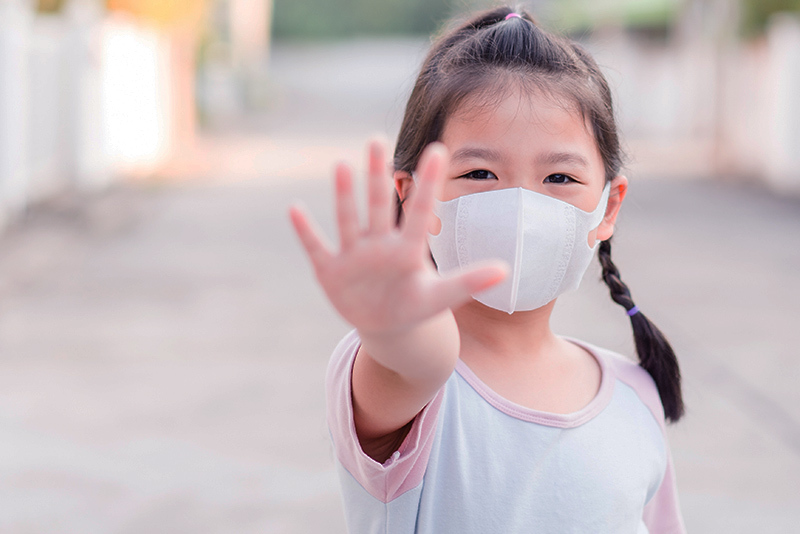Six tips for how families can manage Omicron

Omicron, a highly transmissible COVID-19 variant, is straining hospitals, canceling events, and emptying store shelves of test kits. It seems almost inevitable that it will find its way into households.
Nearly two years into the pandemic, staying on top of COVID-19 guidance can seem exhausting. But you shouldn’t lose hope. Eventually, we will see the other side of the high peak of case numbers, according to Dr. Kristin Moffitt, a pediatric infectious disease specialist at Boston Children’s Hospital. Until then, much of the public health and safety advice that has guided parents through the pandemic still applies — with some key changes.
We asked Dr. Moffitt how families can manage Omicron and what precautions they can take to stay safe during yet another pandemic peak.
Is it safe to send children to school?
Yes. This variant is very contagious, but we know from experience in this pandemic what helps prevent transmission and what will keep kids healthy at school. As the Centers for Disease Control and Prevention recommends in its guidelines for schools, a well-fitted mask and maintaining at least three feet of physical distance between students reduces transmission risk indoors for children 2 years and older, regardless of vaccination status.
Because Omicron is highly transmissible, kids just need to be more vigilant and try to not let their guard down. School is a safe place to be. This surge is related mostly to family and friends having get-togethers over the holidays and spending time indoors without masks on.
Should children participate in other indoor activities?
I do worry that some indoor sports could pose a problem if no masks are worn and ventilation is poor in the facility. This is really an individual choice and one that involves talking with your child, depending on their age. I would, though, advise parents to ensure that the building has proper ventilation through an updated air handling system or even opened windows and doors to ensure good air circulation. Masks should also be worn when possible.
What kind of mask should children wear?
The best mask is a well-fitting mask that a child can comfortably wear for a long time. Data show that cloth masks are not cutting it for Omicron. They filter large airborne droplets but not the smaller aerosols that can carry a virus. And while an N95 mask is the most effective covering to filter large and small droplets, they are not designed for young children and might be harder to wear comfortably for long periods of time.
The best starting point is a multilayered surgical mask — ideally made of at least three layers — that doesn’t have gaps in covering the nose and mouth. This type of mask is comfortable and blocks large-particle droplets that contain the virus, although it will not block smaller particles. Still, a multilayered surgical mask is more effective than a cloth one.

What if a child, or even the whole family, gets COVID-19?
Regardless of vaccination status, anyone with COVID-19 should stay home for a minimum of five days, either from the onset of symptoms or a positive test result, and isolate from others, according to new quarantine and isolation guidelines by the CDC. You or your child can end isolation after five days if you’re fever-free for 24 hours with improving symptoms or if you have had no symptoms but only a positive test. You should wear a mask around others inside your home or in public for five days beyond that.
Now is a good time to prepare for isolation. Make sure you have enough fever medication. Also, stock up on over-the-counter oral rehydration drinks, such as Pedialyte, that can help younger kids stay hydrated through respiratory difficulties. You really have to plan on no one leaving the house if they’re infected, so it’s good to check if you can have food and other items delivered. Or that may mean stocking up on frozen foods.
What should families do if they can’t get a COVID-19 test?
Anyone with symptoms should isolate until they can get a test. If a household member has confirmed COVID-19 and someone else in the house develops symptoms, you should assume that those symptoms are due to COVID-19 while seeking a test. Discuss testing options with your pediatrician.
What else can a family do to combat Omicron?
Vaccinations are still key to preventing serious illness and hospitalization. Omicron is highly contagious and breakthrough infections will still happen for the vaccinated, but vaccines will still keep people out of the hospital.
Learn more about COVID-19 vaccinations for young children and teenagers.
Related Posts :
-

From our labs and clinics: The top 10 COVID-19 science stories of 2021
As COVID-19 waxed, waned, morphed, and waxed again this year, research was taking place throughout Boston Children’s Hospital. Ongoing ...
-

‘Feeling empowered’: How vaccination helped me care for my family when one son got COVID-19
In mid-November, I awoke to an email from my children’s school stating that my second grader, Kyle, had been ...
-

Emerging protein-based COVID-19 vaccines could be game-changing
Current messenger RNA vaccines appear to offer at least some protection against new SARS-CoV-2 variants, including Omicron, especially for people ...
-

Care for post-COVID symptoms helps get figure skater back in the rink
Drew Kenney is no stranger to the ice. As a local and national competitive figure skater, the 16-year-old executes double ...





